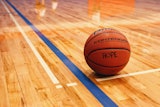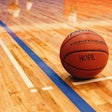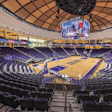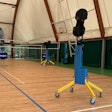Manufacturers push for an ASTM standard that quantifies the performance of wall padding
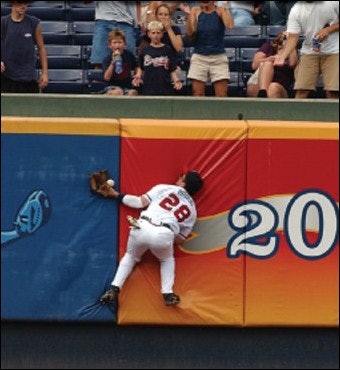
Oct. 28, 1997, was an important day in the life of Lamar Pope, an eighth-grade student at Trotwood-Madison Middle School in Trotwood, Ohio. Like his more than 50 classmates attending an open gym that day, Pope tried hard to impress two coaches of the boys' basketball team who were also present. Official tryouts for the team were only weeks away.
Playing in one of two five-on-five games conducted simultaneously on the gym's cross-courts, Pope was running, as classmate David Robinson later described it, "as fast as he can," when he tripped over another player's legs and was hurled headfirst into a padded gym wall. Robinson lifted the motionless Pope, who was bleeding from the mouth and struggling to breathe. His head "flopped" in a way that suggested Pope had no control over it, Robinson said.
Fast-forward to March 4, 1998, a day that will forever be the most important in the life of Pope's father, Troy, who decided after four months to remove Lamar from life support.
In a subsequent wrongful-death suit filed by the elder Pope, a single parent, against the Trotwood-Madison City School Board of Education, several factors were identified as contributing to Lamar's fatal injury. These include the alleged overcrowding of the gym and the alleged negligence of the coaches for not properly supervising the open gym (they were actively participating in the games) and of the school for hiring coaches not trained in CPR, as mandated by Ohio law. Also at issue, according to the suit, was the condition and protective properties of the padding covering the solid block wall that Lamar Pope struck.
"At some point the mat became worn and inadequate to prevent injury. It was negligence not to replace the mat, but to instead allow it to remain in place giving the appearance that it would provide protection," states one brief filed in the case. "The existence of such a mat actually does more harm than good as it is misleading to those using the facilities."
"The children who were there claim that you could feel the wall through the padding," adds Pope's attorney, David Deutsch, who as of this writing was appealing the summary judgment awarded to the school board. When asked if he personally examined the padding in question, Deutsch says, "I did, and it's full thickness now. They claim they didn't buy new padding. Did they fill it? Because the lower court dismissed our case, there are some issues hanging that may never be resolved."
No wall padding manufacturer is named as a defendant in the case. Nonetheless, the ongoing legal action serves to emphasize the importance for facility operators of choosing and maintaining functional padding in gyms and other athletic venues.
"So many schools don't specify wall padding," says Roger Schmidt, chair of the ASTM International F08 Committee on Sports Facilities and Equipment. "They might say, 'Two inches thick.' Well, that doesn't really tell you anything. If it's two inches of the softest stuff around, it's almost worse than nothing, because you think it's protecting you."
In an effort to take the guesswork out of the wall padding selection process - for architects and facility operators alike - a task group assembled last year within ASTM's Wrestling and Gymnastics Subcommittee has authored a four-page draft that it hopes will establish long-overdue industry standards for wall padding.
"We, as an industry, just sat back for many years and said, 'Well, certain things work, and they'll continue to work.' We didn't do a great job of moving things forward," says Ken John, owner of Promats, one of two wall-padding manufacturers at the forefront of the latest standardization effort. (John co-chaired a similar effort that stalled in 1995 amid lackluster support.) "Our industry just sort of lumped all foams together and said, 'They'll all work OK,' when in reality they don't."
"One of the problems is that schools and architects think that when they're buying padding there's going to be protection, and some of the foams and materials we're seeing used in the field are not very protective," says Paul Gilbert, president of Resilite Sports Products, the other wall-padding manufacturer pushing the standardization agenda. (Of the 48 companies known by Athletic Business to deal in wall padding, roughly 10 actually manufacture it.) "The pads may feel cushiony and look nice, but they don't offer much in the way of shock-absorbency. We want to give decision-makers a tool. They're spending the money anyway; they might as well make sure that what they're buying is suited to the application."
Foam found in wall padding can be categorized into two basic types: open-cell and closed-cell. Open-cell foam allows air to pass from one tiny cell to another when compressed. In closed-cell foam, each cell acts like a balloon, with encapsulated air absorbing the brunt of compression.
"The chance that you would bottom out - in other words, feel the hard surface underneath - is much greater with an open-cell foam," says Schmidt, who is also president of closed-cell foam manufacturer RBX Industries. "There are two ways to get around that. One is to make it thicker. The foam you see around basketball stanchions is usually three or four inches thick, and that gives you enough cushion. The other thing is to encase it in some type of vinyl covering. This covering does two things: It provides abuse protection, but it also traps the air in there. You get a little better cushioning because that air doesn't escape as quickly."
Coverings and backings are two other components affecting wall padding durability and performance. According to John, whose company is one of only a few to manufacture padding for both indoor and outdoor athletic venues, the typical life expectancy of an outdoor wall pad might range between seven and 15 years. Outdoor pads, like those found on the outfield walls and dugout railings in baseball parks and at the base of football goalposts, are usually covered in heavier vinyl that has been treated chemically for UV resistance. "UV is generally what deteriorates the product - not the rain, not the wind, not the dust," says John, adding that professional teams may choose to change out their padding every three or four years for aesthetic reasons, despite the fact the pads are fully functional. Indoor padding, meanwhile, could last indefinitely, John says.
Backing material typically consists of plywood (thicker, marine-grade plywood or plywood that has been sealed are best suited for outdoor applications because of their resistance to moisture), but PVC is also used.
Several varieties and thicknesses of wall pads - covers, backing and all - were tested last year by the F08 wall padding task group, which presented its findings at the Nov. 20 meeting of ASTM in Tampa, Fla. The test involved laying the finished products flat on the ground and dropping a sensor-equipped steel missile from a predetermined height to assign each product a G-max rating, a measurement of how abruptly the missile stops upon impact.
No stranger to the athletic arena, G-max testing has been used to assess the shock-absorbing characteristics of helmets and synthetic and natural turf. According to John, a G-max rating of 200 is the benchmark on which all wall pads should be judged, since head injuries become drastically more severe once that threshold is crossed. In short, the lower the G-max rating, the better. "We're all using such a wide variety of foams, and some perform much better than others," John says. "Why wouldn't we, as an industry, at least begin to weed out the ones that are significantly over 200? Why wouldn't we at least start some dialog as to what an appropriate G-max would be at an appropriate height or speed? That's why we got involved with the ASTM process."
Independent of its involvement with ASTM, John's company in 2002 conducted its own tests of Promats products and those of Promats' competitors. Whereas a drop height of three feet was used in the more recent ASTM testing, Promats determined that a drop height of 11 feet best replicates the speed at which an athlete running a 4.4-second 40-yard dash would hit a padded wall in full stride. "We tried to do G-max testing across the whole spectrum of not necessarily what's likely but what's possible," John says. "Part of the reason for ASTM settling on lower drop heights is because it's more inclusive in terms of what foam is out there. The higher you get, the more you begin to see that traditional foam types may not be adequate."
Schmidt defends the three-foot test, saying it's far more affordable and therefore more easily repeated, while still producing a satisfactory comparison of materials. "If this product performs much better at three feet than that one, I can tell you at 11 feet it's going to be a lot better also," he says.
Moreover, Schmidt contends that ASTM voters (there are three levels of balloting before a draft becomes a standard) would never reach consensus on a standard using Promats' "extreme" (a word even John uses) testing parameters. "When you try to establish a standard, you'd like the test method to somewhat simulate the actual event, but oftentimes this is very difficult if not impossible to do," Schmidt says. "Using Ken John's example of a 4.4 40, are you trying to protect the 99.999th percentile? If so, then you might have a wall pad that costs a prohibitive amount. Maybe what you need to protect is the 95th percentile, which includes someone who is going much slower or some little kid who's just standing there and is pushed by someone against the wall - not someone who's running as fast as he can into the wall, because I'm not sure how many people actually do that."
It should be noted that Promats made its industry mark beginning 18 years ago by padding the walls and fence rails of Major League Baseball parks, an environment, according to John, more conducive than indoor gyms to collisions involving elite athletes running at full speed with eyes fixed on a ball in flight. Walls and rails, after all, are part of a baseball field's playing area, not out of bounds as in a gym setting. "As the years have progressed, they're making fields geometrically more quirky, and the fans are now sitting closer to the action. That has decreased the run-out area. So padding has become really a full-surface project," John says. "We may have started with the outfield, but now you would hardly find a major-league facility in which all the walls and rails are not padded."
But what about the indoor environment and the concept of run-out room? Is it practical for high school administrators to pad an entire gym's perimeter? "There are some realities associated with protection," John admits. "We only have airbags in certain parts of the car - not because manufacturers can't put them everywhere, but because John Q. Public won't pay to have them everywhere. I think the wall padding business is somewhat like that. There is only so much money to do what these folks need to do, and I think they're making some judgment calls in terms of how much is appropriate."
Facility architects and operators are left to prioritize danger zones in their gyms and install padding at their discretion. Currently, National Federation of State High School Associations rules state that within a basketball facility "there should be at least three feet and preferably 10 feet of unobstructed space outside the boundaries." Wall padding is not mentioned. Similar language can be found in NCAA guidelines.
"When I talked to somebody at the NCAA a few years ago about this, they said, 'Oh, well, we're thinking about three feet to spectators, not to a concrete block wall.' But, unfortunately, the architects usually just go to those standards and put a concrete wall three feet from the end line," says risk-management and sport facility planning specialist Todd Seidler, coordinator of sport administration at the University of New Mexico. "That wasn't the intent."
As someone who conducts risk reviews of athletic facilities, Seidler identifies five common wall padding specification mistakes:
• The padding doesn't reach all the way to the floor, leaving unprotected those athletes who dive after loose balls or are tripped.
• The padding doesn't extend high enough to protect particularly tall athletes (he recommends seven feet).
• The padding only encompasses the width of the basketball lane directly behind the basket (he recommends sideline to sideline).
• The padding is mounted on the wall only during varsity basketball games and removed for other gym uses, such as P.E. classes and open-recreation sessions.
• The padding fails to protect participants in other activities - from softball practices to ultimate Frisbee games - likely to take place in the gym (in which case he recommends padding the gym's entire perimeter).
These types of specification shortcomings aren't limited to decades-old gyms, either. Plant High School in Tampa, Fla., built in 1927, leveled its existing gym and began using its replacement in August 2001. Within months of the new gym's opening, junior varsity basketball player Oriana Bruno slammed into an unpadded wall while chasing a ball during practice. As a result of the collision, Bruno sustained a concussion and a broken clavicle, and according to newspaper reports lapsed into seizures before being rushed to the hospital.
Last April, Bruno's parents targeted the school district, as well as construction and architecture firms, in a lawsuit claiming the wall was too close to the court's end line (five feet) and insufficiently padded. Plant athletic director Laura Figueredo declined comment, other than to confirm that since the accident the court has been shortened from 92 feet to 84 feet, and the wall padding extended.
Says Seidler, "It's very common that people won't do anything in the way of risk management - whether it's padding or anything else - until after there's been an injury. They think, 'Well, we've been running our program like this for 20 years, and never gotten sued, so we're just going to keep doing it.' But then all of a sudden, somebody gets severely injured and everybody's scrambling and thinking, 'Oh, why didn't we do this?' Well, that's what risk management is all about. Let's do it up front and prevent the injury in the first place."
And the situation at Plant High isn't isolated. "We have a problem in gyms all over the United States, whether high school or elementary school, of basketball courts that have end lines three or four feet from walls with no padding," says Herb Appenzeller, coauthor of the bimonthly newsletter From the Gym to the Jury. "Padding is something that really should be mandated."
In addition to the Pope case, for which he provided expert testimony, Appenzeller cites two additional recent cases - one involving a recreation center in North Carolina and the other a high school in Montana - in which a lack of wall padding in gyms contributed to brain injuries and substantial out-of-court settlements.
An ASTM standard, however, won't necessarily negate the potential for future tragedies. If the standard passes, adherence to it by manufacturers will be strictly voluntary. Moreover, despite focusing on indoor applications, the current draft offers no guidance for facility operators or architects in terms of wall pad dimensions or distances between court boundaries and brick or concrete walls. "All that we're designing into the specification is that pads meet a certain standard for shock-absorbency," Gilbert says.
Still, once an ASTM standard is in place - discussion of the draft was expected to continue at an ASTM meeting, May 17-20, in Reno, Nev., while the balloting process may take a full year, according to Schmidt - facility operators will no longer be able to plead ignorance to the dangers inherent within the confines of their activity spaces. "I can tell you that when the next case comes up, that argument won't hold water," Schmidt says.
As for the crowded wall padding industry itself, the ASTM standard could bring significant impact.
"Let me phrase it this way," John says. "I think it will make people give greater consideration to whether or not they want to be in this business. Right now, it's very easy to enter this business. It's very easy to offer something. But I think it will make people who are really not as committed to this line think a little harder as to whether they would want to make that commitment."
That said, the goal isn't to leave only a few manufacturers standing, John insists. "We're just motivated, quite frankly, to find the best thing we can to make these environments safer."
"It's not going to put anybody out of business," says Gilbert. "It's just going to guide the industry to manufacture more-shock-absorbent pads. Most of the padding manufacturers already have pads that will meet the ASTM standard. I think it will just result in a better product for the end user."














